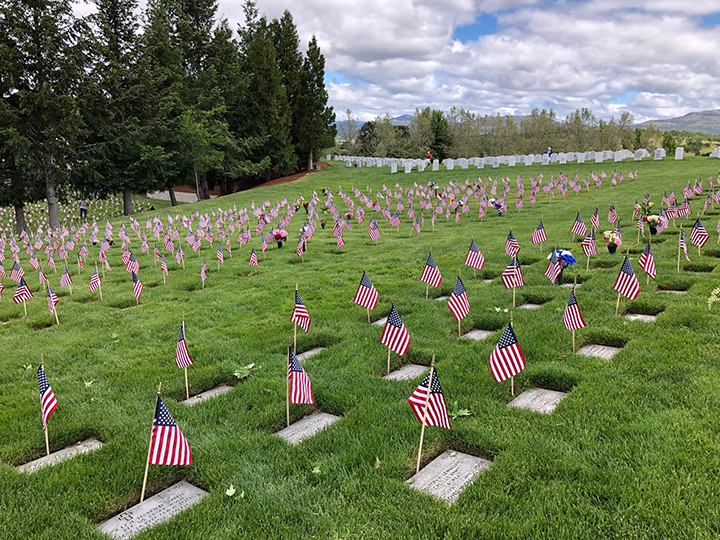In the Studio: Making Motanka — Lyudmila Sokol shares her traditional Ukrainian art with the Rogue Valley
Published 12:00 am Thursday, July 13, 2023

- Lyudmila Sokol makes traditional Ukrainian crafts at the Ashland Fiber Arts Collective on July 5.
Lyudmila Sokol sat by her sewing machine on a recent Wednesday afternoon with satisfaction in her brown eyes.
From her dedicated workstation in the Ashland Fiber Arts Collective, she makes traditional Ukrainian crafts to ease her homesickness without relinquishing her fierce national pride. By keeping her hands busy carrying on centuries of tradition, her mind is distracted from the seven family members a world away fighting in the Ukrainian military.
She can’t speak English, but her expressive face suggests she understands some of what she hears. She responds immediately with her eyes, a nod, a shake of the head, or the word “da,” yes in Russian. She held out her phone with a message in English thanks to Google Translate.
She told the story of her family — husband, Yevhen, daughter Katya and her youngest son Nikita — fleeing the war last year.
“We lived well in paradise. The oldest (children) are already independent. The younger one is involved in sports, he really likes swimming and adores the drums. We were happy. And on February 24, 2022, at five o’clock, WAR … 🙁 We lived for another month, hoping that everything would be over,” she wrote.
“Sirens … for the child’s hand, you run, you hide … and you understand that you have the universe in your hand. That’s all you need, that’s the most important thing in life. Family, children. And you are ready to cover the sky with your hands, and they would be happy.”
Everything fell like sand in an hourglass, she wrote. There was chaos, no work, no way to make money. The family made the decision to flee to Poland.
“We were afraid of everything. And the warmth with which I met amazed me. I am very grateful to the Polish people. And volunteers from all over the world. It impressed me and gave me hope for the future,” she wrote.
The Sokols have been living with an American family in Ashland for around eight months now, estimated Katya Sokol, Lyudmila’s 19-year-old daughter. The name Sokol means “falcon” or “bird who wants to fly,” she said with an ironic smile.
She sat close to her mother, stepping into the language barrier with her still-growing command of English and translated what she could.
Katya pulled out her phone to show her own drawings. There was a card that said “mama bear,” which she made for the mother of the Ashland family sheltering them, “because she is taking care of us, doing everything,” she said.
“We are like one big family now. It is amazing there are so many similarities between us — their parents and my parents, their kids and me. We think the same,” Katya said.
Even as they are happy, there is always the pull of the war.
“We are always waiting for the news, for anything. Even when you are here, everything that happens there, you can feel it,” Katya said, holding a hand to her heart.
Lyudmila bowed her head and wiped tears from her eyes to think about it. But when asked about her art, she sat up straight, her expression a blend of pride and joy. Her crafts are intricate. Nearly everything she makes has a purpose, a story and a reason.
She pointed to a collection of dolls on her display table — Motanka in Ukrainian. In a translated text she described them as “a tradition almost 5,000 years old, an ancient sacred amulet.”
She held out a doll. A slight weight in the hand, it was dressed in a traditional Ukrainian costume with the face blank except for a fabric cross.
“It (the doll) appeared when people began to grow flax. It was made from homespun cloth, dyed with beet juice or elderberries and other natural dyes,” Lyudmila wrote.
The dolls are a tangible part of a bundle of rituals, Katya explained. They have to be made in the course of one day, beginning in the morning and completed at night — nothing can be left for later. The maker also has to be in a positive mood while crafting the charm. They are made by women and gifted for various life events. A marriage or a new baby are occasions for a doll.
“If you want something — like really hard — you can also make a doll for that,” she said.
All Ukrainian crafts must have coordinated colors. The colors of the dolls are no exception, she said, holding up one with various fabrics and patterns, all containing blue, yellow, beige and white. The colors also have meanings — black for sorrow or a connection to the Earth. Green represents nature. Red is love, life and blood. Yellow for the the sun, and blue stands for water.
The dolls are connected to an ancient Ukrainian festival for the approach of winter, Katya said. After the harvest, people used to make life-size versions of the dolls and burn them, then eat crepes.
“Now, people mostly just do the crepes,” she said.
Lyudmila held out two beige fabric balls with symbols embroidered on either side in red and black. Christmas ornaments, Katya said, but the symbols are like words.
A language of smaller symbols functions like letters, which when combined into a final pattern are something most Ukrainians can “read.” It can be a name, or a word like love. This system of embroidery is also used in other crafts, she said, holding out a pendant her mother made with “Anna” stitched in the center.
Lyudmila has also been making traditional Ukrainian costumes — a skirt, a blouse and a vest. Mannequins dressed in similar costumes she’s made stood in the windows facing the street. Picking up a red floral scarf with a luxurious red fringe brought a beaming smile to her face.
“I love,” she said emphatically as she wrapped it around her head.
The scarves were once part of the Ukrainian national costume. Women wore it after they married, Katya said. The scarves were dying away. Only very old women wore them before the war. But now younger people are starting to pick up old traditions as a badge of national pride, Lyudmila wrote.
Lyudmila held out another craft — an elaborate crown of flowers. She smiled to think of the story of this tradition — it was once how Ukrainians got married, or didn’t.
Girls made the crowns from real flowers, carried them to the river and threw them in the water. The current carried them downstream where the village boys were waiting to chose a crown they liked. Once a boy had a crown in hand, he could find its maker and ask for her hand. The girl had the right to say yes or no. If she said no, rejection came in the form of a pumpkin.
Flower crowns are still part of Ukrainian weddings, Katya said. During the ceremony, the bride throws down her flower crown and picks up the scarf. Three times, with ritual crying, she throws down the flowers as her female friends crowd around her, compelling her to wear the scarf, the mark of a married woman. Finally she ties it on and keeps her matrimonial scarf all her life. Katya’s parents have been married 25 years, and her mother still has the scarf, she said.
Lyudmila shared one more translated message about her experience as a refugee.
“We are like neurons scattered all over the world and pulsating, all of us, each in his own place. Our boys protect our Ukraine, and we want to represent Ukraine,” she said.
Katya encouraged helping Ukrainians by sending money or medical supplies — it’s even harder now to earn money or buy basic supplies.
When asked if her mother’s crafts are done to raise money for family at home, she wrinkled her nose but translated the question. Lyudmila shook her head and put her hand on her heart. It doesn’t make much; it’s done for love.
To view or purchase Lyudmila’s work, stop by Fiber Arts Collective at 37 N. Third St., Ashland. Regular shop hours are from 10 a.m. to 4 p.m. Wednesday through Saturday. The collective can be reached by phone at 541-708-6966, or see fiberartscollective.com.
For information on how to help Ukrainians, or to donate money, see unitingforukrainerv.org.






